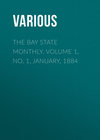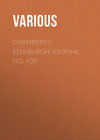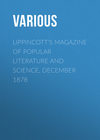Kitabı oku: «Birds, Illustrated by Color Photography, Vol. 2, No. 2», sayfa 4
BIRD SONG – Continued from page 41
with exactness, will deceive Mistress Pullet herself.
To carry the idea further, we will take the notes of some of the birds depicted in this number of Birds. The Osprey, or Fish-Hawk, has been carefully observed, and his only discovered note is a high, rapidly repeated whistle, very plaintive. Doubtless this noise is agreeable and intelligible to his mate, but cannot be called a song, and has no significance to the listener.
The Vulture utters a low, hissing sound when disturbed. This is its only note. Not so with the Bald Eagle, whose scream emulates the rage of the tempest, and implies courage, the quality which associates him with patriotism and freedom. In the notes of the Partridge there is a meaning recognizable by every one. After the nesting season, when the birds are in bevies, their notes are changed to what sportsmen term “scatter calls.” Not long after a bevy has been flushed, and perhaps widely scattered, the members of the disunited family may be heard signaling to one another in sweet minor calls of two and three notes, and in excitement, they utter low, twittering notes.
Of the Sora Rails, Mr. Chapman says, “knowing their calls, you have only to pass a May or June evening near a marsh to learn whether they inhabit it. If there, they will greet you late in the afternoon with a clear whistled ker-wee, which soon comes from dozens of invisible birds about you, and long after night has fallen, it continues like a springtime chorus of piping hylas. Now and again it is interrupted by a high-voiced, rolling whinney, which, like a call of alarm, is taken up and repeated by different birds all over the marsh.”
Poor Red-Breasted Merganser! He has only one note, a croak. Perhaps it was of him that Bryant was thinking when he wrote the stanzas “To a Water-Fowl.”
“The sentiment of feeling awakened by any of the aquatic fowls is pre-eminently one of loneliness,” says John Burroughs. “The Wood Duck (see July Birds) which you approach, starts from the pond or the marsh, the Loon neighing down out of the April sky, the Wild Goose, the Curlew, the Stork, the Bittern, the Sandpiper, etc., awaken quite a different train of emotions from those awakened by the land birds. They all have clinging to them some reminiscence and suggestion of the sea. Their cries echo its wildness and desolation; their wings are the shape of its billows.”
But the Evening Grosbeak, the Kentucky Warbler, the Skylark, land birds all, are singers. They have music in their throats and in their souls, though of varying quality. The Grosbeak’s note is described by different observers as a shrill cheepy tee and a frog-like peep, while one writer remarks that the males have a single metallic cry like the note of a trumpet, and the females a loud chattering like the large Cherry Birds.
The Kentucky Warbler’s song is entirely unlike that of any other Warbler, and is a loud, clearly whistled performance of five, six, or seven notes, turdle, turdle, turdle, resembling in tone some of the calls of the Carolina Wren. He is so persistent in his singing, however, that the Red-Breasted Merganser’s simple croak would sometimes be preferable to it.
But the Skylark —
“All the earth and air
With thy voice is loud,
As, when night is bare
From one lonely cloud
The moon rains out her beams and heaven is over-flowed.”
– C. C. Marble.
THE YELLOW LEGS
YELLOW LEGS, or Lesser Tell tale sometimes called Yellow-leg Snipe, and Little Cucu, inhabits the whole of North America, nesting in the cold temperate and subarctic districts of the northern continent, migrating south in winter to Argentine and Chili. It is much rarer in the western than eastern province of North America, and is only accidental in Europe. It is one of the wading birds, its food consisting of larvae of insects, small shell fish and the like.
The nest of the Lesser Yellow Shanks, which it is sometimes called, is a mere depression in the ground, without any lining. Sometimes, however, it is placed at the foot of a bush, with a scanty lining of withered leaves. Four eggs of light drab, buffy or cream color, sometimes of light brown, are laid, and the breast of the female is found to be bare of feathers when engaged in rearing the young. The Lesser Yellow legs breeds in central Ohio and Illinois, where it is a regular summer resident, arriving about the middle of April, the larger portion of flocks passing north early in May and returning about the first of September to remain until the last of October.
A nest of this species of Snipe was found situated in a slight depression at the base of a small hillock near the border of a prairie slough near Evanston, Illinois, and was made of grass stems and blades. The color of the eggs in this instance was a deep grayish white, three of which were marked with spots of dark brown, and the fourth egg with spots and well defined blotches of a considerably lighter shade of the same.
THE SKYLARK
This is not an American bird. I have allowed his picture to be taken and placed here because so many of our English friends desired it.
The skylark is probably the most noted of birds in Europe. He is found in all of the countries of Europe, but England seems to claim it. Here it stays during the summer, and goes south in the winter.
Like our own Meadow Lark, he likes best to stay in the fields. Here you will find it when not on the wing.
Early in the spring the Skylark begins his song, and he may be heard for most of the year.
Sometimes he sings while on the ground, but usually it is while he is soaring far above us.
Skylarks do not often seek the company of persons. There are some birds, you know, that seem happy only when they are near people. Of course, they are somewhat shy, but as a rule they prefer to be near people. While the Skylark does not seek to be near persons, yet it is not afraid of them.
A gentleman, while riding through the country, was surprised to see a Skylark perch on his saddle. When he tried to touch it, the Lark moved along on the horse’s back, and finally dropped under the horse’s feet. Here it seemed to hide. The rider, looking up, saw a hawk flying about. This explained the cause of the skylark’s strange actions.
A pair of these Larks had built their nest in a meadow. When the time came for mowing the grass, the little ones were not large enough to leave the nest. The mother bird laid herself flat on the ground, with her wings spread out. The father bird took one of the little ones from the nest and placed it on the mother’s back. She flew away, took the baby bird to a safe place, and came back for another.
This time the father took his turn. In this way they carried the little ones to a safe place before the mowers came.
Like our Meadow Lark, the Skylark builds her nest on the ground – never in bushes or trees. Usually it is built in a hole below the surface of the ground. It is for this reason that it is hard to find.
Then, too, the color of the nest is much like that of the ground.
Four or five eggs are usually laid, and in two weeks the little larks crack the shells, and come into the world crying for worms and bugs.










